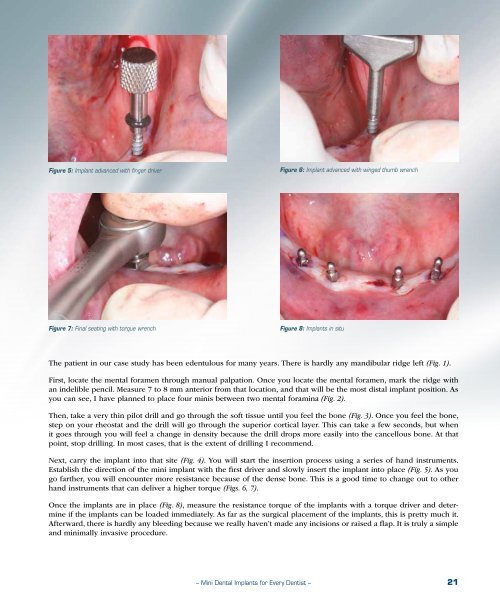Inclusive - Glidewell Dental Labs
Inclusive - Glidewell Dental Labs
Inclusive - Glidewell Dental Labs
Create successful ePaper yourself
Turn your PDF publications into a flip-book with our unique Google optimized e-Paper software.
Figure 5: Implant advanced with finger driver<br />
Figure 6: Implant advanced with winged thumb wrench<br />
Figure 7: Final seating with torque wrench<br />
Figure 8: Implants in situ<br />
The patient in our case study has been edentulous for many years. There is hardly any mandibular ridge left (Fig. 1).<br />
First, locate the mental foramen through manual palpation. Once you locate the mental foramen, mark the ridge with<br />
an indelible pencil. Measure 7 to 8 mm anterior from that location, and that will be the most distal implant position. As<br />
you can see, I have planned to place four minis between two mental foramina (Fig. 2).<br />
Then, take a very thin pilot drill and go through the soft tissue until you feel the bone (Fig. 3). Once you feel the bone,<br />
step on your rheostat and the drill will go through the superior cortical layer. This can take a few seconds, but when<br />
it goes through you will feel a change in density because the drill drops more easily into the cancellous bone. At that<br />
point, stop drilling. In most cases, that is the extent of drilling I recommend.<br />
Next, carry the implant into that site (Fig. 4). You will start the insertion process using a series of hand instruments.<br />
Establish the direction of the mini implant with the first driver and slowly insert the implant into place (Fig. 5). As you<br />
go farther, you will encounter more resistance because of the dense bone. This is a good time to change out to other<br />
hand instruments that can deliver a higher torque (Figs. 6, 7).<br />
Once the implants are in place (Fig. 8), measure the resistance torque of the implants with a torque driver and determine<br />
if the implants can be loaded immediately. As far as the surgical placement of the implants, this is pretty much it.<br />
Afterward, there is hardly any bleeding because we really haven’t made any incisions or raised a flap. It is truly a simple<br />
and minimally invasive procedure.<br />
– Mini <strong>Dental</strong> Implants for Every Dentist – 21

















